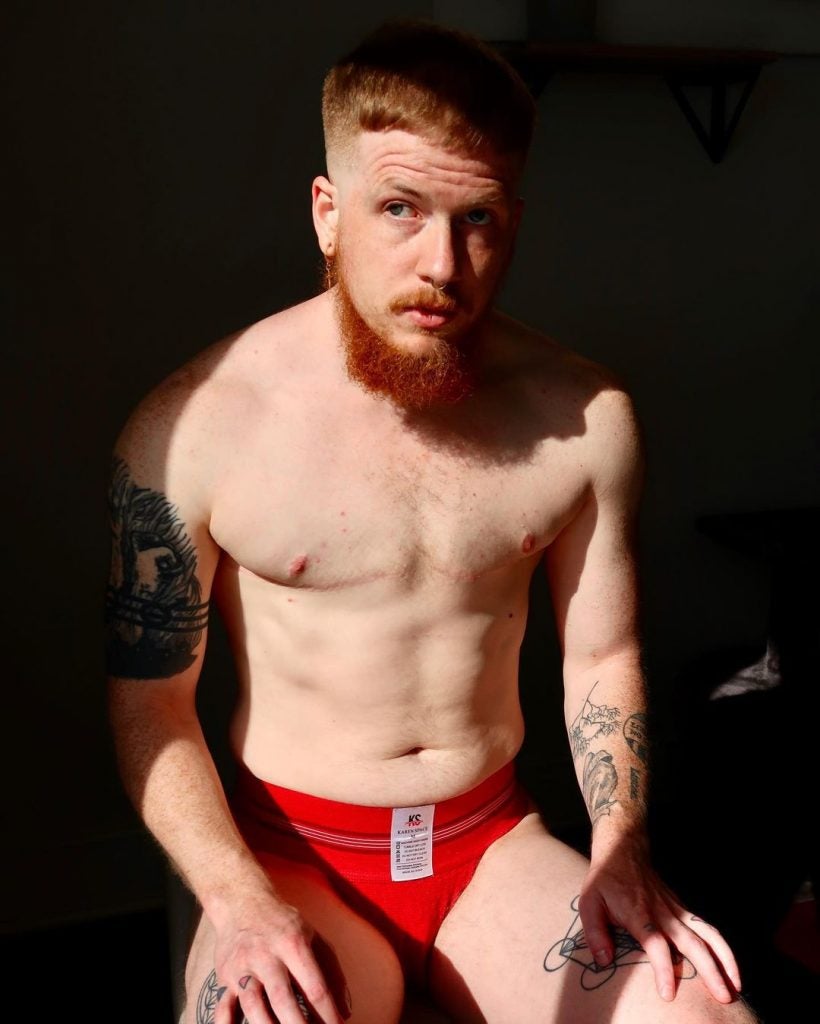In the infamous carol “The 12 Days of Christmas,” the singer brags about all the bossy gifts their “true love” gave them for the holidays. But since since six geese-a-laying and a bunch of turtle doves seem unsanitary — not to mention a violation of city ordinances — we decided to gift you with 12 of something better: A handful of sex workers you should absolutely know about. Whether they’re becoming literary superstars, breaking the “stunt cock” mold or literally embodying gay Jesus himself, they’re the real gifts we need this Christmas. And no, not one of them is a turtle dove.
If you were a woman in New York at the turn of the 20th century, it’s likely you’d have led a fairly solitary life. Public spaces were reserved for men’s booming business talk and hedonistic revelry, while women remained captive in their homes, unable to enter this “domain of men” without an escort. Those craving a night of adventure in a chic-looking bar would be thwarted at the door by an obnoxious sign that read, “No unaccompanied women.” And although they could enter certain bars without a man, doing so would result in the assumption that they were there to sell sex.
And so, women found men to accompany them. Known as “gigolos” (derived from the French word “gigolette,” meaning “hired female dancer”), these men tended to have two modus operandi: Either they were companions of women who wanted a night out, or they could be hired as dancers inside the bars and clubs they escorted them to. Well-off women would pay their chosen gigolo to dance with them, sometimes tipping them for embraces or kisses on the dance floor. What happened afterwards was widely known, but rarely discussed.
“The irony was that you had to hire a sex worker so people didn’t think you were a sex worker,” says journalist and historian Hallie Lieberman, who’s writing a book on the history of gigolos. But while women didn’t want to be misconstrued as sex workers, gigolos seemed to do everything in their power to distinguish themselves as such. They were stick-thin and wore corsets. They were known as “powder puff boys” in reference to their makeup and soft, feminine appearance. They stood in stark contrast to the ideal display of masculinity at the time, which celebrated pomposity and stoicism. But, Lieberman continues, this was why women and their husbands liked gigolos in the first place — they were seen as less threatening to men’s masculinity and women’s safety (though this wasn’t always the case).
According to Lieberman, there’s also an earlier example of the gigolo in the U.S. — an incarnation that dates back to the 1700s but was potentially more similar to today’s interpretation of the word. These gigolos were live-in companions, and were paid by women to marry them, be affectionate or sexual with them or to simply keep them company, much as today’s sex workers who offer the so-called “boyfriend experience” (BFE) tend to do. Three hundred years ago, these men were known as “fortune hunters,” and they targeted elderly, wealthy women.
Today, the term “gigolo” is arguably outdated — John Oh, a straight, Sydney-based escort, believes the term carries stigma and says he’d “rather let it die” — but it remains defined as “a man supported by a woman, usually in return for his attentions” or, more simply, a male escort. While sex workers in the West don’t tend to use the term anymore, gigolo marketing is still dominant in countries like India.
When it comes to modern male sex worker history, eras of masculinity can be defined by trends in wider society. There was the “modern hustler” of the 1950s, who valued traditional masculinity as a sexual ideal. The gender-fluid, experimental hippies of the 1960s and 70s. The 1980s “gay clone,” as Lieberman calls him, who was hairless, muscular and uber-masculine (and often a stripper). The 2000s meterosexual. And now? Skinny, alt-guys are being lusted after in porn; straight escorts are prioritizing gender equality and consent; and trans masc sex workers are ferociously carving out space in the industry. Enter: the era of the multifarious, almost ineffable “new gigolo.”
Within this new generation is 33-year-old Stevie Trixx, an FTM (female-to-male) companion and porn creator on OnlyFans and JustForFans. Trixx grew up as a “tiny queer child” in a conservative, rural town in Upstate New York, but is now settled in L.A. He considered himself a “genderless kid” — though “more on the masculine side” — but started seriously questioning his gender identity when he was in college in the mid-2000s. In 2011, he started taking hormones, and he had top surgery the following year.

For a while, Trixx worked as a freelance journalist, mostly writing about trans issues — specifically about how trans men belong in gay porn. At the same time, he was doing some escorting on the side, and soon decided that he’d rather “actively participate in making change happen” by creating his own porn, as opposed to just writing about the need for it. So, in 2017, he devoted himself to porn and escorting full-time.
When he started in the industry, Trixx says FTM porn was “such a small thing.” It was basically only available on the FTM site Jockpussy, and he struggled to get in with any of the studios. He still does today, actually — while there are more trans men in porn now than ever, it’s still a tough industry to break into, and lots of trans mascs stick to escorting, self-produced porn or other forms of sex work. “There’s backlash when some of these sites do put a trans guy up,” he explains. “But this is porn, are we not pushing boundaries?”
We are, it seems. Trixx — a broad, muscular redhead with a tidy mustache and asymmetrical arm tattoos — has since become an industry heavyweight, holding the accolade of TEA’s Best Trans Man Performer 2021, and boasting over 100K followers on Twitter. Alongside his self-shot porn, Trixx is available to hire for his “passionate, gentle and heavily loving” boyfriend experience, which he says attracts “very curious” clients who often ask him a lot of questions about being trans (“in that environment, ask away,” he says). “It’s funny,” he adds, “because I more or less identify as non-binary — more on the masculine side — but porn and escorting are places to channel my masculinity, and play it up a little bit more.”
Unlike the gigolos of the 1920s, who were often nothing more than a sexual playdate for the night, an experience with Trixx is much more intimate, as he aims to cater to clients’ emotional, as well as sexual, needs. For some, he may play a comforting, protective role — “When was the last time you sunk into someone’s arms and just let yourself relax?” he writes on his website — while others may be after someone to listen and offer advice. “As a queer, transgender person, I’ve experienced a sweeping segment of the spectrum of sexuality. I learned not to judge myself or my desires, and I extend that generosity to everyone I meet,” he continues.
Trixx, who mostly works with gay men, says his look, combined with his gentle and tender nature makes him well-suited for the gay community. “A lot of gay porn is really pushing extremes — harder, faster, bigger — but I’m more interested in shooting with someone I have good chemisty with, and showing something a little more realistic,” he says. The fact that Trixx is shooting gay porn — a section of the industry that’s traditionally been hostile to trans masc performers — and, as an escort, has gay male clients, highlights how trans men are pushing sex work in a new direction. “Trans men aren’t making the kind of money that probably anyone else in the industry is making,” says Trixx, “but we’re literally building this new wave from scratch.”
Jordan Green, a 24-year-old Manchester-based FTM OnlyFans creator and escort who sees both men and women, says he also tends to take on a more macho role with his female clients. One of his regular BFEs is a gay woman who wants to see what it’s like to have a boyfriend before she decides whether or not to start dating men. As she’s quite nervous about the arrangement, Green says he’s “very much in charge,” and so gets to act more masculine in her presence — his preferred state of being. This includes what he calls “the stereotypical stuff,” like holding doors open and pulling her chair out for her when they go for dinner. Green also says he’ll sometimes “talk on behalf of both of us, which sounds really sexist, outdated and patriarchal,” but it’s something that comes naturally when the pair are together.

Green, who does sex work on the side of his full-time job in a call center, dabbled with porn in his teens, but started taking it more seriously in January last year. He came out as trans and started taking testosterone four years ago, and says that at the start of his transition, he was “quite fruity and stereotypically gay.” But, it felt like he was putting on an act. Sex work has given him the confidence to express himself more masculinely, but it still felt like a hindrance when he first started as an FTM performer and escort.
“People don’t take you seriously, especially if you’re not the stereotype, which is soft, feminine boys,” he tells me. “For a long time, that put me off — I didn’t think I was the right guy to do it.” Green says he started standing out and succeeding after making the decision to stay true to his own style — that is, “tracksuits and trainers.”
Historically, gigolos have catered to female clients. Lieberman says even queer men would sell sex to women, and when they couldn’t get hard, they’d go down on them instead (hence their nickname: “fish queens”). However, in his book, Economics, Sexuality and Male Sex Work, Trevon D. Logan points out that “women are very rarely the clients of [cis or trans] male sex workers,” adding: “The popular image of a male sex worker as a gigolo stands in contrast to the limited evidence that women have ever made up anything more than a negligible fraction of the client base for male sex workers.” While this likely has some standing, female consumers of paid sex have rarely been written about, and even in the era of the “new gigolo,” it’s much harder to find big names who cater exclusively to women. “It’s almost impossible to find women clients,” Green confirms. “Mostly I think because of the stigma of seeing sex workers.”
That is, in part, because in a patriarchal society, women can’t win — they face more scrutiny as both providers and consumers of sex. With this in mind — and with little information available about the preferences or habits of women who buy sex — it’s hard to determine whether there’s an increasing market for women seeking queer, non-cis escort that buck the old gigolo stereotypes. In Green’s experience, there really isn’t.
What is known about female clients, however, is that guaranteed consent is a big factor in their decision to hire escorts. “Women are seeking out safer experiences,” says Lieberman. “Because consent isn’t guaranteed in a regular heterosexual relationship, women are actually willing to pay for it. That says a lot.”

Oh, who’s been a straight male escort for 11 years, says consent is central to his work “because of the power dynamic and the inherent vulnerability of most women when in the company of a man.” This comment may hint that there is, in fact, a market for women seeking trans or non-binary escorts, whose company they might feel safer in. Nonetheless, Oh says the industry of straight men for women is also still “relatively immature.” Unlike men looking for either men or women — who can find a suitable escort via a quick Google search — Oh says his clients usually do two to six months research before reaching out to him. Key to their thorough investigation is deciding on whether Oh is the right man to respect their emotional needs and vulnerability. “That’s the first and most important thing,” he tells me. “If a woman doesn’t feel confident that I will be respectful and safe, then she simply won’t contact me.”
Oh — a trim man with a mop of soft-looking, curly gray hair — started escorting shortly after the 2008 financial crash ruined his IT business, costing him two-thirds of his customers in two years. Within four years of setting up his website, he was able to make escorting his full-time job. Much like in the LGBTQ+ escorting scene, his clients’ desires have diversified over the last decade, especially in relation to looks, personality and identity. Agencies still advertise young guys with “gym-fit bods,” but a string of alternative independent providers (like non-binary, Melbourne-based dominatrix Sai Jaiden Lillith or London-based “sex and intimacy coach” James Gandy) are cropping up, many of whom are older men, queer or gender-fluid providers and anyone who offers substance over style.
They, of course, don’t cut nearly the comical figure as their predecessors, nary a heeled boot, rib-squashing corset or makeup brush in sight. And yet, their calling remains the same as it ever was: the complete and total pleasure of whoever is on their arm — and in their bed.

